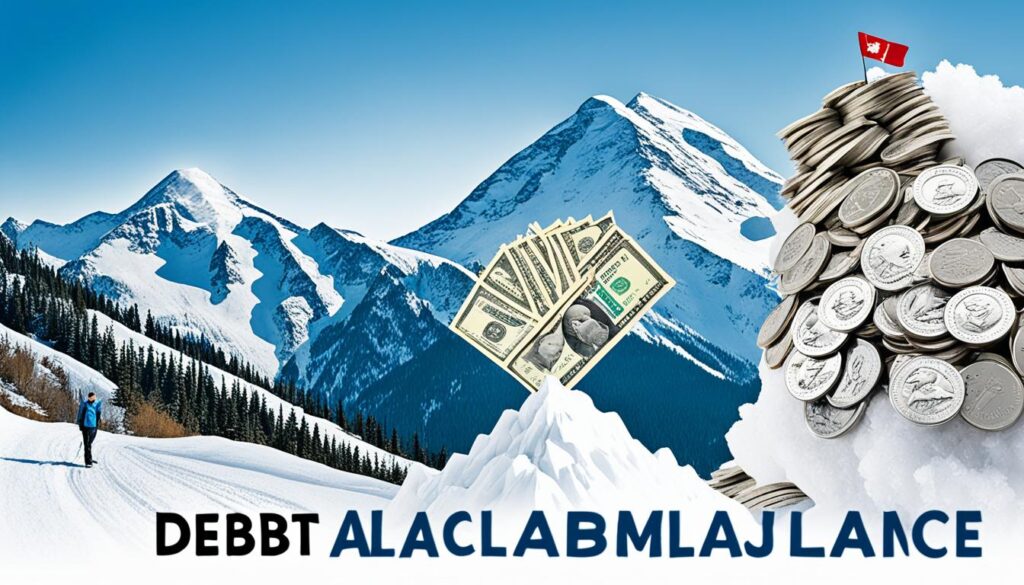Are you struggling with a lot of debt? Maybe you’re looking for a way out. The debt snowball method could be your answer. It’s a smart way to pay off debts and give you back your financial freedom.
It was made known by money expert Dave Ramsey. The idea is simple. You start paying your smallest debt first, forget about the interest rates. This strategy helps you see fast progress. Small victories keep you inspired.
Key Takeaways:
- The debt snowball method involves paying off debts from smallest to largest balance.
- This method prioritizes quick wins and progress to keep you motivated on your debt repayment journey.
- Unlike the debt avalanche method, the debt snowball method provides a psychological boost by paying off smaller debts first.
- Create a comprehensive list of all nonmortgage debts to prioritize them in your debt snowball.
- Increase your income and cut expenses to allocate more money towards your debt snowball.
- Building an emergency fund is crucial to handle unexpected expenses without relying on credit.
- Seek support through resources like Financial Peace University to stay committed to your debt snowball.
The Debt Snowball vs. the Debt Avalanche: Which Method is Best for You?
Two common ways to reduce debt are the debt snowball and the debt avalanche. Each has its pros and cons, so pick the best for your situation.
The debt snowball method starts with your smallest debt. You pay the minimum on others. As you clear each smaller debt, you feel good and more motivated. It focuses on progress and boosts your confidence to stay debt-free.
The debt avalanche tackles high-interest debts first. It helps you save money in the long term. But, it might be tough if your big debts take a while to pay off. This needs discipline and thinking long-term.
Choosing the right one depends on what pushes you towards paying off your debts. If you like seeing quick results and the feeling of clearing small debts, go with the snowball method. If you’re all about saving more money and can handle slower progress, try the avalanche method.
Considerations for Choosing the Right Method:
- Personal Motivation: Figure out what drives you. Do you like seeing progress fast, or do you care more about saving money in the end?
- Debt Balance and Interest Rates: Look at what you owe and the rates. For many small, low-interest debts, the snowball can be fast. High-interest debts might need the avalanche method to save more in the long run.
- Financial Discipline: Think about your self-control. The avalanche needs more patience since it’s about the long game.
- Psychological Factors: Consider how you handle stress and debt. The snowball’s small wins can boost your mood and keep you going.
Remember, both the debt snowball and the debt avalanche methods are effective debt reduction strategies. Choose the one that aligns best with your goals and life.
Comparison of Debt Snowball and Debt Avalanche Methods:
| Method | Debt Snowball | Debt Avalanche |
|---|---|---|
| Strategy | Pay off smallest debts first | Pay off highest interest rate debts first |
| Psychological Motivation | Sense of accomplishment, quick wins | Focused on long-term savings |
| Potential Savings | May not save as much in interest over time | Potential for greater long-term savings |
| Progress | Visible progress with smaller debts | Slower progress, especially with high-interest debts |
Both methods can make you debt-free. The trick is to find what works best for you. Try both and see what helps you stick to your financial goals.

Tips for Success with the Debt Snowball Method
The debt snowball method is great for paying off what you owe. It has some steps you can follow to make it work well.
First, list all your debts not including your house loan. This list should have things like student loans, credit card bills, and car payments. Put them in order from the smallest to the biggest. This will show you which to tackle first.
Next, make a budget that’s more than just the lowest payments. You might need to earn extra money by working more or selling things. Also, find ways to spend less. This pumps more funds into your debt repayment.
Don’t forget about your emergency fund. It’s money set aside for sudden big bills. This way, you won’t need to use credit cards or take out loans, slowing down your progress. A safety net helps you focus and keeps you from increasing your debt.
To keep going, stay excited about reaching your financial dreams. Join groups or use resources like Financial Peace University. They help you stay on track and inspired. With perseverance, the debt snowball plan can lead you to a debt-free life.


